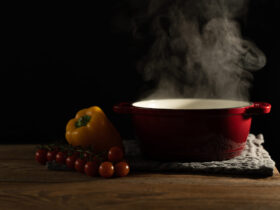Salt is just salt, right? Think again! Salt is one of the most fundamental elements in our diet and plays a crucial role in the culinary world. However, despite its ubiquity, most people know surprisingly little about this essential mineral.
Theory: What is Salt?
Salt is a chemical compound mainly composed of sodium (Na) and chloride (Cl) elements, occurring in the form of small crystalline grains. It’s a mineral found in nature in various forms but can also be artificially produced. In food preparation, salt is used as a seasoning and plays an important role in our diet since sodium is an essential element for the human body. It’s also utilized in many other applications, including food preservation, water treatment, and the chemical industry.

Sea Salt or Rock Salt?
Basically, all salt is sea salt. The sea salt we’re familiar with comes from fresh seawater and must be obtained through evaporation.
Rock salt also originates from the sea but from evaporated seas millions of years old. It occurs in very large salt beds or formations called salt domes. Hence, rock salt must be mined from underground deposits.
Where Does Salt Come From?
Salt comes from various sources and can be obtained in different ways. Here are some main sources of salt:
- Sea Salt: Extracted from seawater, sea salt is evaporated in shallow basins, leaving behind salt crystals. These crystals are then collected, dried, and processed.
- Rock Salt: Originating from salt deposits below the Earth’s surface, formed over millions of years, it’s mined through mining procedures.
- Salt Lakes: Some regions have salt lakes where salt crystallizes naturally from the water. This salt can then be collected and processed.
- Salt Mines: Salt mines extract salt from underground deposits, one of the most common methods of salt extraction.
- Brine Springs: In some areas, there are natural brine springs from which salt is obtained. These brine sources are often rich in salt and accessed through drilling.
- Seawater Desalination: Some companies extract salt from seawater using evaporation ponds or modern methods like electrolysis.

Varieties of Sea Salt
- Fleur de Sel: This premium sea salt has delicate, hand-harvested crystals. It forms on the surface of salt ponds during seawater evaporation. Valued for its fine texture and delicate flavor, it’s often used as a finishing salt in upscale cuisine.
- Grey Sea Salt: Coarse grey salt, also known as grey sea salt, is the most natural sea salt with a characteristic grey color. It’s obtained from seawater and contains mineral trace elements influencing its color and taste. It has a coarse texture and is used in the kitchen for seasoning dishes.
- Maldon Salt: Maldon salt is a high-quality sea salt named after the town of Maldon in Essex, England. It’s distinguished by its pyramid-shaped, crispy crystals, offering a mild, salty flavor. Often used as a finishing salt by sprinkling it over dishes, it adds a crispy texture and delicate saltiness.
- Halen Mon Salt: Also known as Anglesey Sea Salt, it’s a high-quality sea salt originating from Anglesey Island in Wales, UK. Obtained from seawater, it has a delicate, salty taste with a hint of minerals, prized for its purity and quality.

Practice: Salting Meat and Fish for Juicier Results
During cooking, proteins in meat and fish coil around themselves, squeezing out water, similar to wringing out a wet towel. Quick-cooking meats lose about 20%-30% of their raw weight, while slow-cooked meats lose about 40%. Salting alters the protein structure, preventing excessive water loss, resulting in juicier, tender meat. For fish fillets, salting ensures they remain translucent and minimizes the formation of white foam on the surface.
Salting Meat: To allow salt to penetrate deep into meat, salt it at least a day in advance or immerse it in a wet brine (use about 60g of salt per liter of water). Always use the same amount of salt you would use after cooking—neither more nor less.
Salting Fish: White fish fillets need about 20 minutes in a salt brine (use about 60g of salt per liter of water). Oily fish may require more time due to their higher fat content.

Conclusion
- Salt takes longer to dissolve and penetrate our food than most people believe.
- Salt doesn’t dissolve well in oil. When making dressings, dissolve salt in liquids like vinegar, lemon juice, water, or juice before adding oil.
- If you turn your food too early, the salt often simply falls off without having had enough time to penetrate.
- Steam surrounding your food often dissolves a significant portion of the salt again.
Understanding the properties and practices of salt can significantly enhance your culinary skills, ensuring your dishes are seasoned perfectly for optimal flavor and texture. Whether it’s selecting the right type of salt or mastering the art of salting meat, a little knowledge about salt goes a long way in the kitchen!














Leave a Reply
View Comments